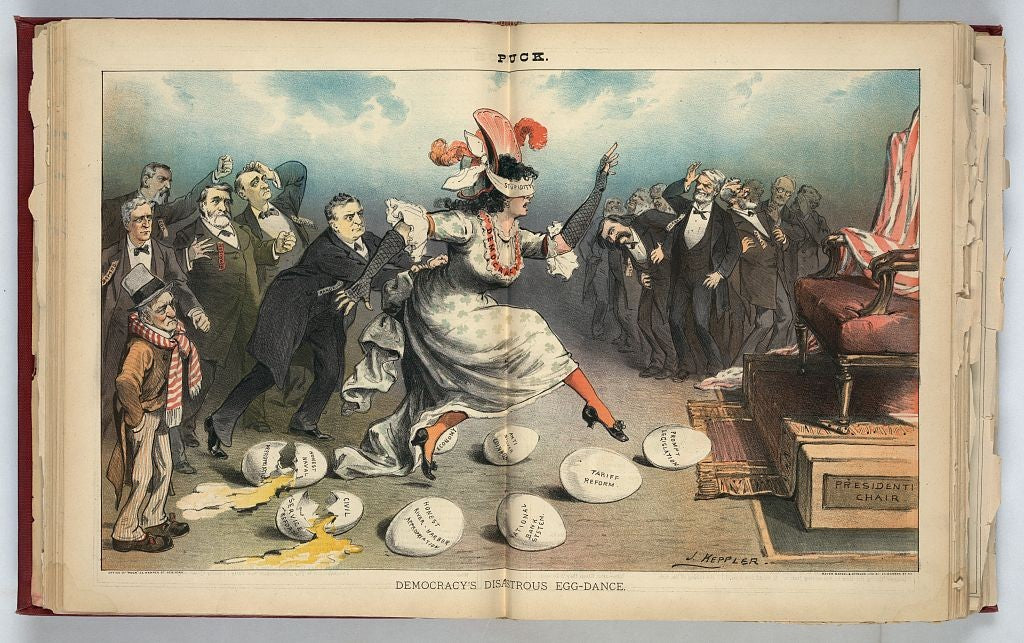The egg cup is one of those charmingly absurd inventions that seem utterly unnecessary. Yet its history stretches back to 1700 BC, and it has something interesting to tell us about the art of table.
The Philosophy of table Objects: The Egg Cup

Above Democracy's disastrous egg-dance .Cartoon from the American magazine Puck from 1884.
What is an Egg Cup, Really? : A Brief History of Breakfast Theatre
We sit down to eat and rarely notice the stage beneath our meal. The table may be dressed in linen or left cheerfully bare, but it's the smaller players, the egg cup, the salt cellar, the butter knife that shape the whole affair.
Roland Barthes called familiar objects "myths," stories wrapped in ceramic and silver. What masquerades as simple utility is often an entire philosophy hiding in plain sight. Today, one object steps out from the breakfast table shadows: the egg cup.
A Throne for the Humble Egg
Let's address the elephant in the dining room: the egg cup seems utterly unnecessary. An egg does not, strictly speaking, need a throne. You could scramble it with abandon or eat it over the kitchen sink.
But where's the theatre in that?
Eggs carry a cargo of symbolism: fertility, rebirth, cosmic perfection. When Odilon Redon painted his mysterious glowing egg in 1885, he understood this. To place an egg in a cup is to elevate breakfast into an event. The fragile egg is held in a miniature pedestal that declares: This moment matters.

The Egg 1885 by Artist: Odilon Redon, from France, 1840-1916 (Image courtesy of Art Institute Chicago)
A History More Ancient Than You'd Think
The egg cup's backstory stretches back millennia. Archaeologists found footed goblets at the palace of Knossos in Crete, dating to around 1700 BC. The Minoans, with their labyrinthine palaces and bull-leaping acrobats, sat down to breakfast with their eggs propped just so.

A SET OF ROMAN SILVER EGG-CUPS FROM THE 1ST CENTURY A.D. (Image credit: www.christies.com)
The Romans continued the tradition a silver egg cup was discovered in Pompeii, preserved beneath Vesuvius's ash. By the Middle Ages, egg cups were crafted from silver and pewter at wealthy tables. Then came the 18th and 19th centuries, when European porcelain factories turned them into tiny canvases, painting florals, landscapes, and witty sayings.

This historically significant silver artifact was discovered on September 20, 1887, at location VIII.2.23 and is currently housed in the prestigious Naples Archaeological Museum (Image courtesy of Pompeii in pictures).
Why We Still Need Them
The egg cup is a masterclass in design: too wide and the egg wobbles; too narrow and it won't sit. Its existence shows how an object transforms necessity into culture. An egg cracked onto a plate is fuel. An egg in a cup? That's breakfast with intent.
In an age of protein shakes and sad desk salads, the egg cup is an ancient quirk. It insists that how we present food matters. It refuses to apologize for being small, specific, and arguably frivolous.
Because an egg cup isn't really about eggs at all. It's about the belief that beauty belongs everywhere even at breakfast. That rituals, no matter how humble, anchor us. That objects, when made with care and used with intention, become something more.

Ready to elevate your breakfast table? Discover our collection of beautiful, handcrafted egg cups here because every egg deserves its moment in the spotlight.